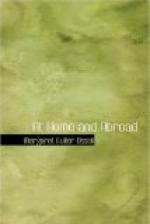Rome, December 30, 1847.
I could not, in my last, content myself with praising the glorious weather. I wrote in the last day of it. Since, we have had a fortnight of rain falling incessantly, and whole days and nights of torrents such as are peculiar to the “clearing-up” shower in our country.
Under these circumstances, I have found my lodging in the Corso not only has its dark side, but is all dark, and that one in the Piazza di Spagne would have been better for me in this respect; there on these days, the only ones when I wish to stay at home and write and study, I should have had the light. Now, if I consulted the good of my eyes, I should have the lamp lit on first rising in the morning.
“Every sweet must have its bitter,” and the exchange from the brilliance of the Italian heaven to weeks and months of rain, and such black cloud, is unspeakably dejecting. For myself, at the end of this fortnight without exercise or light, and in such a damp atmosphere, I find myself without strength, without appetite, almost without spirits. The life of the German scholar who studies fifteen hours out of the twenty-four, or that of the Spielberg prisoner who could live through ten, fifteen, twenty years of dark prison with, only half an hour’s exercise in the day, is to me a mystery. How can the brain, the nerves, ever support it? We are made to keep in motion, to drink the air and light; to me these are needed to make life supportable, the physical state is so difficult and full of pains at any rate.
I am sorry for those who have arrived just at this time hoping to enjoy the Christmas festivities. Everything was spoiled by the weather. I went at half past ten to San Luigi Francese, a church adorned with some of Domenichino’s finest frescos on the life and death of St. Cecilia.
This name leads me to a little digression. In a letter to Mr. Phillips, the dear friend of our revered Dr. Charming, I asked him if he remembered what recumbent statue it was of which Dr. Charming was wont to speak as of a sight that impressed him more than anything else in Rome. He said, indeed, his mood, and the unexpectedness in seeing this gentle, saintly figure lying there as if death had just struck her down, had no doubt much influence upon him; but still he believed the work had a peculiar holiness in its expression. I recognized at once the theme of his description (the name he himself had forgotten) as I entered the other evening the lonely church of St. Cecilia in Trastevere. As in his case, it was twilight: one or two nuns were at their devotions, and there lay the figure in its grave-clothes, with an air so gentle, so holy, as if she had only ceased to pray as the hand of the murderer struck her down. Her gentle limbs seemed instinct still with soft, sweet life; the expression was not of the heroine, the martyr, so much as of the tender, angelic woman. I could well understand the deep impression made upon his mind. The expression of the frescos of Domenichino is not inharmonious with the suggestions of this statue.




